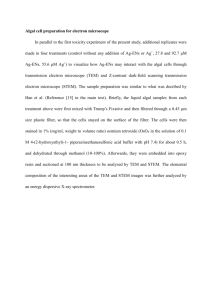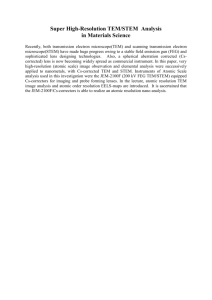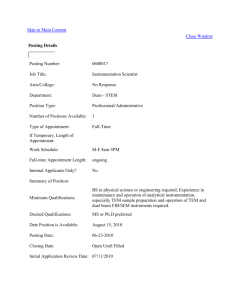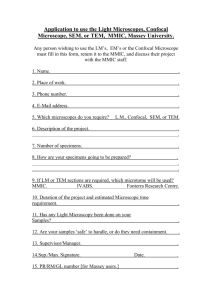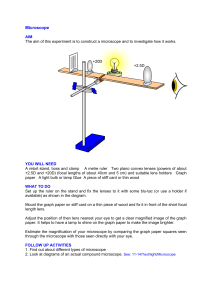Cryogenic Optical Microscope
advertisement
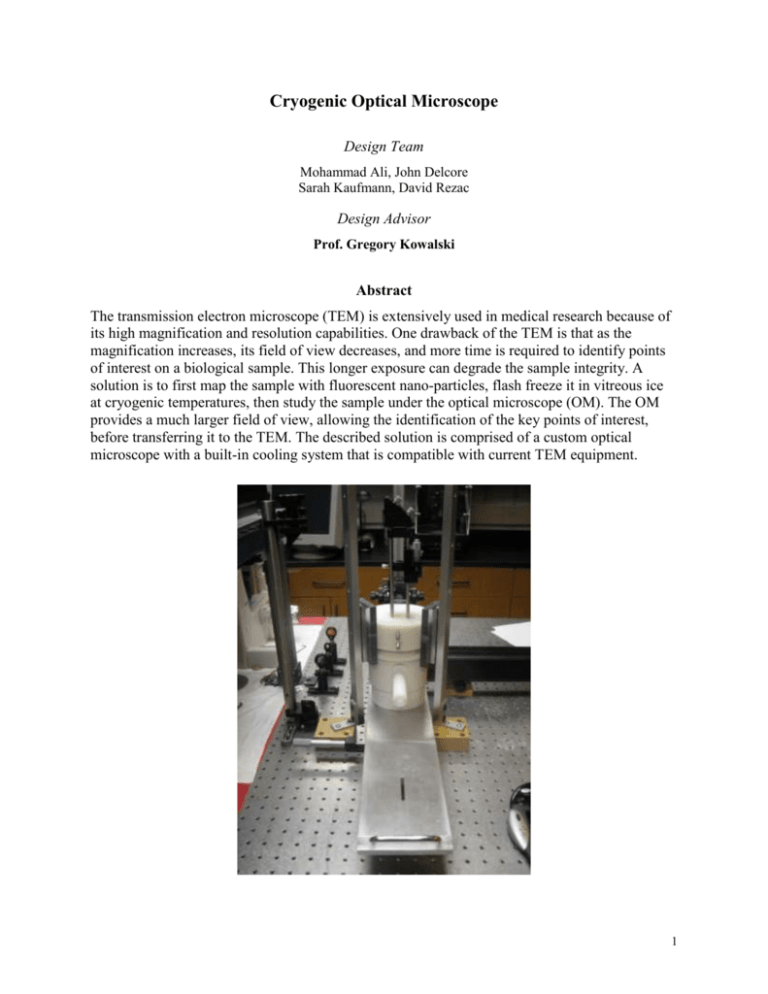
Cryogenic Optical Microscope Design Team Mohammad Ali, John Delcore Sarah Kaufmann, David Rezac Design Advisor Prof. Gregory Kowalski Abstract The transmission electron microscope (TEM) is extensively used in medical research because of its high magnification and resolution capabilities. One drawback of the TEM is that as the magnification increases, its field of view decreases, and more time is required to identify points of interest on a biological sample. This longer exposure can degrade the sample integrity. A solution is to first map the sample with fluorescent nano-particles, flash freeze it in vitreous ice at cryogenic temperatures, then study the sample under the optical microscope (OM). The OM provides a much larger field of view, allowing the identification of the key points of interest, before transferring it to the TEM. The described solution is comprised of a custom optical microscope with a built-in cooling system that is compatible with current TEM equipment. 1 The Need for Project This project will increase the The results of this project will aide research and development for quality and quantity of images improved therapeutic advancements. It will lead to increased for biological samples. productivity by improving the quality and quantity of TEM images. The process enables microscopists to specifically label molecular components with the large field of view of an OM, and then study those components in more detail with the high resolution of the TEM. This will be done without increasing the complexity of current sample preparation, resulting in no additional user training or expertise. The Design Project Objectives and Requirements The project objective is to design Design Objectives an optical microscope that will The study of biological samples requires the magnified views produce images of a provided by optical and electron microscopes. The samples to be cryogenically frozen biological viewed are frozen in order to obtain a snapshot in time of what is sample, and provide means to happening within a cell’s components. A biological sample blotted on a cross-reference these images grid can be imaged in a TEM for a minimal amount of time before it is with the TEM. rendered useless by the bombardment of electrons. A TEM is the optimal microscope because it offers the best image quality due to its high resolution capability. In order to locate small structures in the crowded environment of cells at that resolution, it is necessary to first image the sample at cryogenic temperature in an OM and identify those locations. Currently there is no method to achieve this. Design Requirements The process has to allow for imaging in the optical microscope while maintaining the specimen below -140oC for long enough to image. It must enable the transfer from the optical microscope to the transmission electron microscope. It must allow for mapping of the sample with florescent nano-particles that will provide reference points between the two microscopes. This will require an objective lens with an acceptable, while not optimal, resolution capabilities. There must be negligible vibrations within the system, consistent with allowable vibrations with the current process. It cannot introduce any outside moisture or undue stresses on the grid that would result in deformation. Design Concepts considered The initial design concepts All of the possible solutions generated were based on the utilized liquid nitrogen and a background research and were formulated within the scope of the 2 standard optical microscope setup. design constraints. They all included using a standard optical microscope and liquid nitrogen as the cooling agent. One of the initial design concepts is shown below. It involves an inner bath of liquid nitrogen that contains the sample to be viewed, which is attached to an external reservoir. Both the top and bottom surfaces of this inner bath are glass, or some other optically equivalent material. This outer chamber surrounds the bath and acts to increase the overall heat gradient in the structure. The N2 gas is then vented out of this chamber into the atmosphere away from the optical equipment. One iteration of this design was to introduce a vacuum in the outer chamber and vent the N2 gas directly into the atmosphere, which would effectively eliminate convection in the outer chamber and limit all heat transfer to that which occurs by radiation. Another concept included a removable top that would allow for easy access to the sample and transportation thereof, as well as possible incorporation of current electron microscope staging elements to streamline the overall process. Recommended Design Concept The recommended design fulfills Design Description all of the requirements. It utilizes Below is the completed design setup. The base sits on a manual liquid nitrogen as the coolant, x-y translator that positions the sample for each image. This design incorporates the TEM cold finger, incorporates the existing TEM cold finger, which inserts into the requires custom bench top optics, opening on the PTFE dewar. This minimizes sample handling, and minimizes vibrations by resulting in no additional contamination or exposure to moisture. The sitting on 1000 lb table. metallic skirt that sits over the dewar also aids in isolating the sample from the outer temperature and humidity. The Z-translator operates with a dovetail design and three guide rails. This allows the optics to come within the working distance of the objective lens. The emitted 3 light is then passed through an assortment of filters and mirrors arriving at the imaging camera. A laser excites the fluorophores seen by the optics. The following close-up shows the position of the sample when viewed under the cold air objective lens. The blue represents the liquid nitrogen reservoir that sits just below the sample. The sample is kept at cryo-temperatures from the evaporated nitrogen. Analytical Investigations This final design evolved from the initial design concept’s thermal modeling. It was determined that, with the initial design and standard objective lens’s maximum working distance of 4mm, the temperature at the outer surface of the upper glass is 16° C. This temperature is close to the dew point temperature, and could cause condensation. Therefore, the thermal gradient needs to be overcome without increasing the working distance. The group found a cold air objective lens that operated at cryogenic temperatures and performed with the necessary resolution. By using the cold air lens and custom optics, the 4 design could be built using the current TEM process equipment. Experimental Investigations Testing was done to evaluate the time needed for the liquid nitrogen to reach a calm state without any nucleate boiling. This test resulted in the realization that the mass of the PTFE was too large to reach steady state within a reasonable amount of time. Because of this, the dewar was modified, as shown below, and insulated with Styrofoam. Key Advantages of Recommended Concept This design meets all of the design requirements, in addition to incorporating the TEM cold finger. It also minimizes vibrations by sitting on a 1,000 lb table. Financial Issues Approximate overall cost of The major costs incurred during the prototyping process included prototype is $7,000.00. approximately $900 for the cold lenses, $4500 for the laser, and $550 to modify machined parts from an outside vendor. Funding for the project was provided entirely by the sponsor. Recommended Improvements The four key improvements to the design include automating both the x-y and the z translator, There are four key changes to improve on the current design. First would be to automate the x-y translator and the dovetail z-translator. This would prevent the technician from having to manually adjust the coupling the design with a more location after every image, and more accurately place the objective powerful camera, and enclosing within the required working distance from the sample. The third the optics. change would be to switch to a more powerful CCD camera that has an adequate signal-to-noise ratio for single molecule fluorescence imaging. The last improvement is to encase the optical components into one package, which would serve to eliminate readjustment issues. These desired improvements will make the use of the microscope easier and faster. This will result in ease of use for the technician, and an increase in image quality. 5
